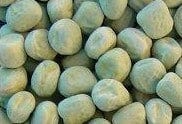
You might wonder, it being the season for fresh peas, where the alt-food business would be without this venerable pulse. Replacing soy criticised for its environmental damage, pea protein and pea flour go into meat-free mince, sausages, meatballs; alt-milk, cheese and dairy; baking mixes and more.
Are we growing enough of them?
Yes. The peas producing their protein magic are not those tender green beads brought in fresh from the garden to eat as soon after they are picked as you can manage. “Sweet as the moment when the pod went Pop”, as the Bird’s Eye ad went, Clarence Birdseye being the first person, in 1952, to freeze peas. My mother used to steam my father’s garden peas as soon as we ran in with a colander-full of pods harvested from the tangle of peasticks up which they grew. She would serve them as they were, unpodded. We each had a bowl of melted butter into which we would dip the whole pea, grasped by its stalk. First we would nibble to unlock the pods, then suck out the peas, and finally grind our teeth along the young pods as if an artichoke leaf, leaving little of the casing to be discarded. Not the salacious activity it sounds but a delicious one.
The peas the alt-food business is after are not those garden jewels. They are peas allowed to dry out in the field, and so little trouble to grow that farmers love them, with the extra benefit that they pull nitrogen from the air to put back into the soil. Almost old as time, these pulses were grown to feed people nutritiously during the winter months. Throughout the Middle Ages, they kept famine at bay.
The very first peas go so much further back - to 7000-5000 BC, the late Neolithic area, according to archaeological finds in what are now Syria, Anatolia, Israel, Iraq, Jordan and Greece. Peas show up in 5000 BC in Georgia, then in the Nile Delta from around 4800 BC, and a century later in Upper Egypt. By 2000 BC they’re found in Afghanistan, then in northwestern India, and so on and on and on. By the 3rd century BC, peas are so prolific and influential that Theophrastus, the Greek philosopher commonly considered the father of botany, is writing about them.
But those are all field peas, with no-one involved in their growth thinking to pick them to eat when tender. Garden peas, as such young peas are called to distinguish them, only date from the 18th century, developed by amateur plant breeder Thomas Edward Knight of Downton, near Salisbury, England. Before that, sugar peas emerge - mange-tout in French, because eating every bit of them is what you do. These were introduced during the reign of Henri IV of France (1553–1610) by the French ambassador to Holland where they were developed in Dutch market gardens.
In January 1660, an event with as much pomp, circumstance and drama as theatres on Broadway and Shaftesbury Avenue contrive took place in the French court of Louis XIV - to introduce young green peas from Genoa.
Slide your imagination into a Hollywood groove. Now picture the Comte of Soissons of Savoy, a Franco-Italian nobleman married to the niece of the King’s chief minister, Cardinal Mazarin, dressed to the fashionable nines.
With suitable flourishes, he takes up the role of sous chef and begins to shell the pods from a sumptuously decorated ceremonial hamper of young peas that have been presented to the King. With mounting excitement, the jade beads within are distributed among gorgeous little dishes and presented to His Majesty, to the Queen, the King’s brother, and Cardinal Mazarin. The pea as a means of winning friends and influencing the court - who knew.
Thirty six years later, young peas were still considered a luxury reserved only for the very wealthy when Influencers of their day Madame de Maintenon (the second - and secret - wife of Louis XIV) and Madame de Sévigné (the celebrated letter-writer) both declared them “a fashion, a fury”.
These days, it’s China, promoter of so many soy-based foodstuffs which is the nation that also produces the most peas, at more than 12 millions tons. Next is India at around 5 million tons. Then there’s a massive drop, to the USA at 0.31 million, and France at around 0.23 million tons. After that we have Egypt, then the UK, Pakistan, Algeria, Peru and Turkey to complete the Top Ten producers. As a Brit, I’m surprised we come so low on the list. If I’m asked to nominate our unique national food it’s marmalade that springs to mind, but peas are what I’d cite as our national vegetable. But I suppose it’s probably crisps.
They were the favourite vegetable of Thomas Jefferson, who grew several varieties. At Monticello, his Virginia estate, there was a friendly competition about who could produce the first crop. It was always Mr George Divers, a neighbour, who invited the others to a dinner featuring them as the star of the meal. “Come to-night - the peas are ready”, went the urgent summons. One year, Jefferson’s peas were ready before Mr Divers’. His family urged him to dispatch his own invitations immediately. “No,” he told them. “Say nothing about it. It will be more agreeable to our friend to think he never fails.” A President of the United States with no vanity.

600g/21oz peas
175g/6oz spring onions/scallions
1 clove garlic, peeled and finely chopped
175g/6oz butter
1½ litres/2¾ pints water
250ml/8floz whipping cream
a few mint leaves, finely minced, or chive stalks, finely snipped
Soften the onions and garlic in half the butter in a saucepan. Add the peas with the water and simmer till the peas are tender, no longer. Blitz into a puree in a blender then push through a sieve. Return to the cleaned out pan and bring gently back to the just-before-boiling point. Pour in the remaining butter and cream, and season to taste. Stir in the mint or chives and serve.
This is also good cold. But use single not whipped cream and add a generous squeeze of lemon juice.
If you follow the recipe but don’t add the water, you have a puree that is delicious under a steamed white fish, such as halibut or cod.







What an informative and witty piece. Thank you. There’s nothing like those fresh garden peas with hot butter. Except perhaps sweet corn similarly run from the plant to the pot in seconds.